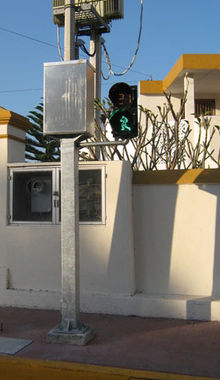- Deep cycle battery
-
A deep-cycle battery is an lead-acid battery designed to be regularly deeply discharged using most of its capacity. In contrast, starter batteries (e.g. most automotive batteries) are designed to deliver short, high-current bursts for cranking the engine, thus frequently discharged of only a very small part of their capacity. While a deep-cycle battery can be used as a starting battery, the lower "cranking amps" imply that an oversized battery may be required.
A deep-cycle battery is designed to discharge between 50% and 80% depending on the manufacturer and construction of the battery. Although these batteries can be cycled down to 20% charge, the best lifespan vs cost method is to keep the average cycle at about 50% discharge,[1] as there is a direct correlation between depth of discharge on the battery and the number of charge and discharge cycles it can perform.[2]
Contents
Structure
The structural difference between deep cycle batteries and cranking batteries resides in the lead battery plates. Deep cycle battery plates have thicker active plates, with higher-density active paste material, and thicker separators. Alloys used for the plates in a deep cycle battery may contain more antimony than starting batteries.[3] The thicker battery plates resist corrosion through extended charge and discharge cycles.
Applications
- Cathodic protection
- Industrial electrically-propelled forklifts and floor sweepers
- Motorized wheelchairs
- Off-grid energy storage systems for solar power or wind power, especially in small installations for a single building
- Power for instruments or equipment at remote sites
- Recreational vehicles
- Traction batteries to propel vehicles, such as golf carts, and other highway electric vehicles
- Traffic signals
- Trolling motors for recreational fishing boats
- Uninterruptible power supply
- audio equipment
Flooding
Flooded batteries will decompose some water from the electrolyte during charging, so regular maintenance of flooded batteries requires inspection of electrolyte level and addition of water. Major modes of failure of deep-cycle batteries are loss of the active material due to shedding of the plates, and corrosion of the internal grid that supports active material. The capacity of a deep cycle battery is usually limited by electrolyte capacity and not by the plate mass, to improve life expectancy.[3]
Recycling
The vast majority of deep cycle batteries on the market today are lead acid batteries. Lead acid batteries are recycled at a rate of 98% by volume, 99.5% by weight. The plastic cases, lead plates, sulfuric acid, solder, and other metals are 100% recovered for reuse. Only one portion of a battery is not recyclable: the paper separators that wrap the plates. Due to the acid bath the paper sits in, the fiber length is reduced so far that it can not be rewoven.
Industry wide, there is a 97% rate of recovery on all lead acid batteries sold in the United States, resulting in a virtually closed manufacturing cycle.[4]
See also
- Desulfation
- Electric vehicle battery
- Gel battery
- VRLA battery
References
- ^ "Deep Cycle Battery FAQ". Windsun.com. http://www.windsun.com/Batteries/Battery_FAQ.htm. Retrieved 2011-07-20.
- ^ http://www.bdbatteries.com/images/lifelinelifecycles.jpg
- ^ a b David Linden, Thomas B. Reddy (ed). Handbook Of Batteries 3rd Edition. McGraw-Hill, New York, 2002 ISBN 0-07-135978-8, pages 23-44 to 23-53
- ^ "Battery Recycling". Batterycouncil.org. http://www.batterycouncil.org/LeadAcidBatteries/BatteryRecycling/tabid/71/Default.aspx. Retrieved 2011-07-20.
External links
Categories:
Wikimedia Foundation. 2010.

